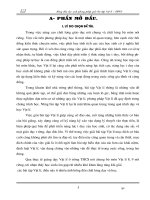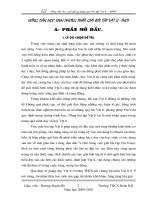giải bài tập vật lí đại cương
Bạn đang xem bản rút gọn của tài liệu. Xem và tải ngay bản đầy đủ của tài liệu tại đây (164.12 KB, 4 trang )
Irodov Problem 1.153
As soon as the spring is released it
pushes the mass B upwards. When B moves high enough, it will stretch the spring causing it to
pull mass A upwards. Finally when spring is stretched enough, it will have enough tension to
overcome mass A weight and lift it up. The problem can be solved easily with conservation of
energy.
Suppose that the mass B, at some instant, is at a height h above the relaxed (un-stretched) length
of the spring as shown in the figure. Suppose that the vertical velocity of B is v at this instant and
mass A has not left the ground yet. Then the total energy of the system is the sum of i) the
potential energy stored in the spring due to its extension given by , ii) the kinetic energy of
mass B given by and iii) the potential energy gained by mass B during its motion
upwards given by (since it has gained a height of since its initial position
when the thread was intact). The initial energy content of the system is only that stored in the
compressed spring given by . Since energy is conserved we have,
There are three forces acting on mass A, i) the force of gravity mg pulling it down, ii) the tension
in the spring and iii) the normal reaction from the ground N. Since mass A is resting on the
ground it has no acceleration.
When, mass A is about to leave the ground, the normal reaction becomes 0 and so we have,
a) When the initial compression in the spring is just enough for mass A to leave the ground,
the maximum height to which mass B will rise will be equal to the extension needed in the spring
to lift A off the ground given by (3). At its highest point, mass B will have its velocity v=0 in (1).
So using this condition and substituting (3) in (1) we have,
Ignoring the negative possibility we have,
b) If the initial compression is , mass B will still be moving upwards when mass A
lifts off the ground (at ) , i.e. v>0. We can compute this vertical velocity v by using
equation (1) as,
The velocity of the center of mass of the system when mass A is about to leave the ground is
given by,
The kinetic energy of the CG when mass A is about to leave the ground is given thus by,
Before mass A has left the ground, if mass B moves x units upwards, the CG will move x/2 units
upwards. By the time mass A is about to leave the ground, mass B has moved up, so
the CG would have moved up a height of . The total energy of the CG just before
mass A leaves the ground is sum of its kinetic energy and its potential energy and is thus given
by,
This energy ECG must be conserved at all time. When the CG reaches its maximum height, its
velocity will be zero. Suppose that the maximum height the CG attains is H, then it would have
gained a potential energy of 2mgH and kinetic energy will be 0. So applying conservation of
energy we have,
If then .









